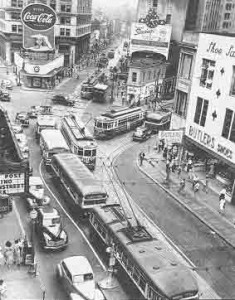This Article on Architectural exclusion provided analysis on the subtle ways our built environment is controlled by private city planners and the government through architecture and the justice system has turned a blind eye to it. Architecture regulatory power intentionally builds obstacles for the less fortunate, to keep them excluded from well off places. Notice in wealthy neighborhoods there are no bus systems usually. This is because well off homeowners and many white communities see many who rely on public transportation as people of color, homeless, burglars, gang members, and other people who they see may be up to no good and cause harm to them and their families. This results in bad sentiments towards a large group of people who in turn get pushes out of areas and denied opportunities because of the social blockade that’s placed in society figuratively and literally. Even in New York Robert Moses, the “Master Builder” guided the city’s infrastructure into inequality building low hanging overpasses so buses couldn’t pass through Long Island parkways leading to Jones Beach (Architectural Exclusion). This isn’t the first time something has been designed to keep the unwanted out. Throughout history there have always been barriers to exclude people out of a certain area. Today it’s hard to see from the surface but it’s there. It’s also intentional. Social scientist and urban planners know the behavioral effect of how our environment gets shaped, but yet they keep going with it because the courts see it as hard to prove inequality over usage of land. Most people are oblivious that architectural exclusion even still happens now that it’s not as blatant as Jim Crow. However, it still is out there even in the simplest things we wouldn’t even think twice about such as a bench in a park. The bench is made with arm rest and it designates 3 seats for the entire bench, this also may be architectural regulation to keep the homeless from sleeping on the benches. See! It’s subliminal and this is why the justice system fails to realize the inequality in our built environment today.
Most built environments are constructed to further political goals and not the public. They know infrastructure will have a certain effect on groups of people but they proceed to build it because of economic gain and prejudice preconceptions. Lessig explicitly states how built environment can serve as regulation. He brings up how when two neighborhoods are divided by a highway they’re less likely to interact with one another, than a town that has a square with easier access to shops and amenities of the neighborhood. He talks about how in Paris, there are long boulevards that limit the ability of revolutionaries to protest. This is a direct example of how our physical “built environment” plays a role in our behavior. Often not thought about, places have racial identities based on the patterns of excluding certain groups of people out through history. This is why we may have preconceived notions about some places because of their historical background. Even though the place is not a living thing and doesn’t blatantly discriminate on its own, the people who occupy the space give it its identity by holding a reputation for exclusion. “Lior Jacob Strahilevitz examines ‘exclusionary amenities’, which are features of residential developments that are generally expensive and only appeal to certain demographic groups. By including these features in a common interest community, a developer can deter unwanted potential residents—generally poor and people of color—from buying homes in that development.” (Architecture as Architecture in Legal Scholarship: Racialized Space and Place, Briefly). Strahilevitz takes a closer look on exclusion by looking at the market. If many people of color cannot afford a certain rent or mortgage, they will of course be forced out so when a developer intentionally makes it unaffordable for a certain demographic to live in the area, it could be construed as injustice. Intentional exclusion happened in places like Long Island, New York, Cleveland, Ohio, and Detroit, Michigan. In New York, Robert Moses, suggested to have a “social-class bias and racial prejudice” built a low hanging overpass so twelve-foot tall buses couldn’t pass limiting minorities and low-income groups from accessing Jones Beach, he even vetoed a proposal extension to extend Long Island railroad to the beach. In other instances there are walled and fenced in ghettos and housing projects made to separate preexisting black neighborhoods from new white ones and extremely isolate them from the rest of the environment.

8 Mile Wall in Detroit

Overpass headed to Jones Beach in New York

Robert Moses




